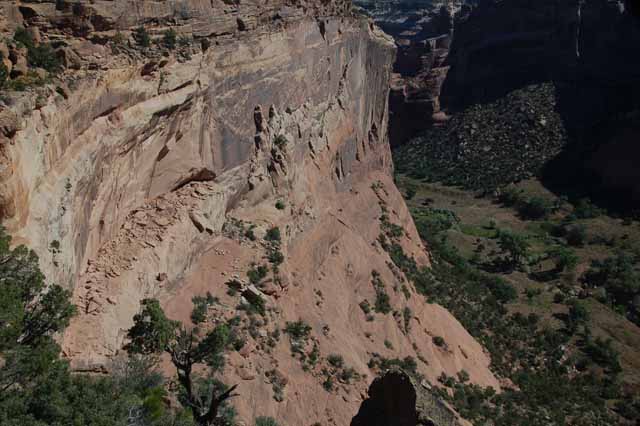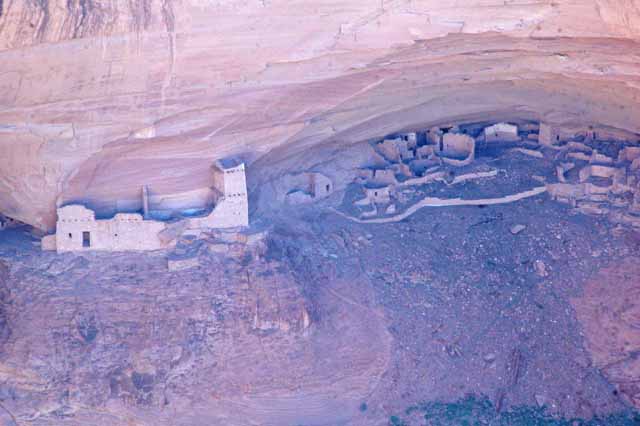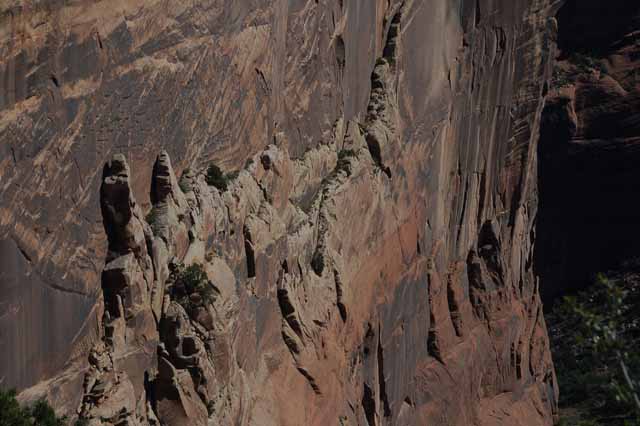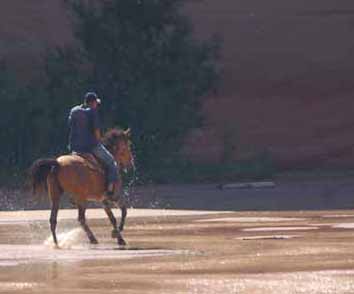the wandering chick
...Canyon de Chelly Natl Monument
northeast Arizona
Canyon de Chelly (pronounced "de SHAY") is a highlight of the Four Corners area. Its history and beauty are evident at each of the overlooks along the North and South Rims. Though the divisions are sublte, the national monument is actually made up of three canyons: del Muerto, de Chelly and Monument.
The ancient ruins of the Pueblo cave dwellers are fascinating, appearing as miniature blocks despite the fact that many of them, nestled deep into the towering rock, actually have 9-foot ceilings.
There are two highlights at Canyon de Chelly: the White House ruins, which are the largest of the Puebloan dwellings, and Spider Rock. Both are on the South Rim, so if your time is limited, drive the South Rim and take in the overlooks. It's less than 20 miles and has wonderful view points.
There is a hiking trail to the White House ruins, and it's also possible to catch a Shake and Bake tour through the canyon floor from any number of Navajo tour companies in the area.



On the South Rim of the canyon is Massacre Cave with a lot of history and a lot of rock. More than 100 Navajos, as recent as 1805, were killed here by a Spanish military expedition.
This is at Mummy Cave on the North Rim named for two mummies that were found at this site by archaeologists. It's believed that 80 rooms made up this complex and that Puebloans lived here for 1000 years, from A.D. 300 to 1300. The actual size of the complex cannot be appreciated, since we can only view it from 1000 feet above.
Tunnel Overlook is one of the viewpoints on the South Rim.
Tsegi Overlook offers a great view of the canyon floor. Tsegi is the Navajo name for 'rock canyon.'
Sliding House Overlook was my second favorite viewpoint in Canyon de Chelly, even though I couldn't locate the 'sliding house.' The massive, bold rock was incredibly impressive to me. So impressive that I forgot to look for the 'sliding house.' Oh well, at least check out the corral at the bottom of the rock, and the sheep (left) on the ledge. Everything is so tiny in comparison to the towering surroundings. I know, you can't even tell they're sheep. They look like white rocks. But I know they're sheep 'cuz rocks don't move. Below is a closer view of the corral.
Zoomed out (below) you can see how the Puebloans used the overhang of the massive walls as protection from the weather.
A Navajo child selling wares with her older sister near their home on the canyon floor.
From the canyon floor, the Puebloan ruins appear more actual in size.
There are many areas of petroglyphs and pictographs on the walls of the canyon, made by the ancient Puebloans and Anaszi Indians. These appear to be pictographs, meaning they were painted or drawon on the rock. Petroglpys have been chipped or carved into the rock.
The White House ruins are the most spectacular of the Puebloan dwellings in the canyon. It's amazing that all of the ruins have been renovated in recent times by a mere 10 percent. Ninety percent of each set found is in its original state. None of the ruins' grounds can be walked upon by tourists; they are all off-limits; however, there is a trail to these ruins, the White House ruins, but a fence prohibits entry any closer than this shot was taken.
The White House ruins were on two levels, the bottom level giving access to the top level. They were built by the Anasazi, the Navajo word for "the ancient ones," some 800 years ago. Its name is believed to have derived from a white wall that had been painted above the rooms.
The not-to-miss of all of Canyon de Chelly is Spider Rock. Some say it should be named Spider Woman Rock, as it was believed in Navajo legend that a woman who weaved patterns into the rock lived on top of the larger spire.
A unique sandstone monolith, it juts out of the canyon floor to rise 800 feet. You may recognize it from TV ads. It is located at the most southern end of the South Rim, and a 200-yard paved walking path leads to an excelling viewing point.
A shake and bake tour through the canyon floor will offer scenes such as this. They are called shake and bake tours by the locals because the cushioned seats in the back of the six-wheel drive truck offer little comfort to the jostling that goes on; and there is little overhead protection from the heat and sun.
Feel free to visit my other Arizona pages by returning to the Arizona home page.
Or, choose a location below.
Thank you for visiting these photo pages.
If you're interested in seeing more, please return to the Main Menu at the bottom of my home page and make your selection.
All images within 'The Wandering Chick' Web site are copyright protected. They may not be downloaded or otherwise copied.
Please contact me if you think a particular photo or set of photos can be used in your publication.
